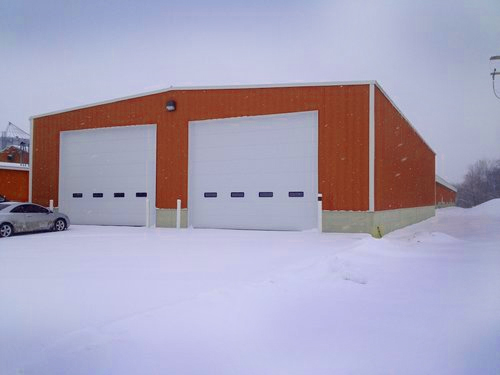Winter Farm Shop Energy Efficiency Checklist and Tips
The farm shop is often the second most used building during the winter next to the home. It needs to be well insulated and sealed to keep energy use to a minimum.
Questions to Ask:
- Is insulation adequate in the walls, ceiling, and doors of the shop?
- Do the doors fit tightly to limit air infiltration?
- Do you have insulation around the shop floor and foundation that extends at least two feet below ground?
- Do you use your waste engine oil for heating the shop?
- Do you have good economical lighting in the shop?
- Do you have a minimal amount of windows in the shop?
- Are windows double-glazed?
- Do large shop doors face south or east?
- Do you have a dense shelter-belt on the west and north sides of your farmstead?

- Install insulation with an R-30 to R-40 value in the ceiling and R-18 value in the sidewalls. Doors should have an R-value of 10 to 12 (2 inches of foam insulation).
- Install weatherstripping if doors do not fit tightly and allow significant amounts of cold air in. Air infiltration is one of the largest heat wasters in many buildings. Install one or two inches of extruded polystyrene (enclosed cell insulation) at least two feet below ground level around the shop foundation. Any concrete exposed above ground level needs insulation and the insulation above ground needs to be covered to prevent physical damage from birds, rodents, and sunlight. Be sure to extend the insulation cover well below ground level for at least six inches or more. The foundation insulation should lap the wall insulation to provide continuous insulation.
- Waste engine oil is an excellent source of heat. Used engine oil tends to accumulate extremely fast during times when farm engines are operating. Store this oil in a large barrel to use for heating during the winter. Several manufacturers make waste oil heaters and many can use fuel oil if the waste oil runs out. Service and inspect heaters annually to ensure proper operation.
- Keep the number and size of windows to a minimum. They increase heat loss and limit usable wall space for tools. Also, they usually provide little light in the shop as the days are short in winter and the light they provide is usually near the wall where they are installed.
- Install double- or triple-glazed windows to help reduce heat loss and reduce moisture condensation. A window with single glazing will have an R-value of about 0.9, whereas a double-glazed window with an inert gas between panes will have an R-value of 3.0 to 4.0, reducing heat loss by 60 to 75%.
- Good overhead lighting is a necessity in a shop. Use pulse-start metal halide or T-8 fluorescent lamps for economical lighting that will keep electricity use to a minimum and give good lighting to work on equipment. T-8 lamps are recommended because they will use about 25% less electricity for the same amount of light as the pulse-start metal halide, provide light instantly and will not flicker in cooler temperatures like the common T-12 fluorescent lamps do. Metal halides can take 2 to 3 minutes to emit light; therefore if used it would be helpful to have some compact fluorescent or T-8 fluorescent lamps to provide light when you enter the shop or running in to grab a tool or part.
Farm Shop Facts and Actions You Can Take
- Install large doors for bringing machinery in and out of the shop so they face away from prevailing winter winds. Prevailing winter winds are usually from the northwest. Installing the large doors facing south or east will prevent a considerable amount of heat loss when doors are opened. Bring large, cold equipment inside the shop to warm up the night before working on it.
- Use zone heating. Heat only the areas that need to be heated with directional or radiant heaters – over work benches, for examples. They heat the objects but not the air directly. Separating the shop from the storage area, even with a plastic curtain, can save a significant amount of heat. Turn off or turn down the heat when it is not needed. If using unit heaters, use the power-vented or condensing type and avoid gravity-vented unit heaters. A power-vented unit heater and a condensing type unit heater are 13% and 28%, respectively, more efficient than a gravity-vented unit heater.
- Dense shelter-belts reduce the wind velocity and the energy needed to heat the shop. Short, dense trees should be located on the edge of the shelter-belt and taller trees in the middle. Shelter-belts should be a minimum of 200 feet from the shop or other buildings to reduce the problem of snow build up.
Additional Resources
- Planning Farm Shops AE-1066, North Dakota State University Extension Service, Fargo, ND 58105.
- Farmstead Energy Audit North Dakota State University Extension.
- Farm Shop Plans Book. Iowa State University, Publication MWPS-26 Includes floor plans, cross sections, and construction details. Also covers preplanning, layout, materials, equipment, utilities, furnishings, safety, and the environment. Available for a fee at Midwest Plan Service.
- Farmstead Windbreak, North Dakota State University, F-1055, 1996.
- Energy Efficient Agricultural Lighting, University of Wisconsin Extension, A3784-14,2004.